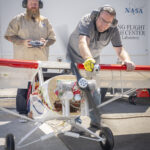No rainstorm is needed for this new type of rainbow — it’s made of sounds.
A normal rainbow separates light waves of different hues, or wavelengths. The different colors that make up sunlight fan out to appear side-by-side in the sky. Now, an oddly shaped plastic device does the same thing with sound waves. It sends the different wavelengths — or pitches — that make up white noise into distinct places around the device. In effect, it creates an acoustic rainbow.
Rasmus Christiansen is part of a team that described the new invention June 13 in Science Advances. A physicist, Christiansen works at the Technical University of Denmark. It’s located in Kongens Lyngby.
Tools such as this could be used for a variety of things, his group says. For instance, it could help control the acoustics of a room by sending certain pitches into a sound absorber.
A sound idea
The new device was inspired by the structure of human ears. The outer ear doesn’t split noise up into pitches. But it does help people determine where different pitches are coming from.
A source at the center of the gadget makes noise from about 8 to 13 kilohertz. Those sound like very high notes. (The highest note on a piano is around 4 kilohertz.) Zeroing in on those frequencies let researchers keep their acoustic rainbow generator small. It’s about the size of a human ear. To handle lower notes, it would have to be bigger.
The gizmo works thanks to a smattering of misshapen pillars. Those pillars reflect sound waves in a way that makes them cross paths, or interfere. When waves interfere, they can reinforce or cancel each other out. The result of this complex dance is that sound waves of different pitches get amplified at different places around the device.
Design difficulties
Building a structure that can create an acoustic rainbow is complex. Why? Because juggling sound waves of varying wavelengths is such an intricate process.
To overcome that challenge, Christiansen’s group did something called inverse design.
First, they used a computer model to see what field of sound waves a given design would create. Then, they compared that output with the acoustic rainbow they were going for. They kept tweaking their blueprint until its sound field matched the rainbow.
Once the design was fine-tuned, a 3-D printer produced a prototype. Lab tests showed that it worked as intended.
The pillars inside the device may seem “very random-looking or weird-looking,” says Christiansen. “But they really serve their purpose well, because they’ve been tailored for providing exactly what we asked for.”




